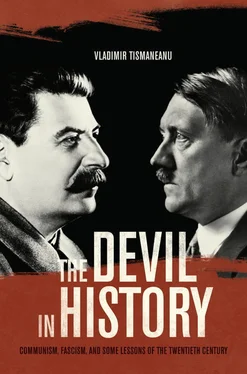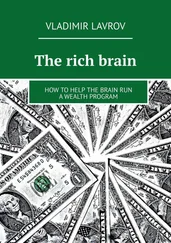In 1919 Lenin created the Third (Communist) International—the Comintern, a global institution that the Fascists were never able to establish. Earlier he had lambasted the Second International for its loss of revolutionary fervor and complicity with bourgeois parliaments and governments. The Comintern consecrated Moscow’s centrality and hegemonic role within world Communism. For a party to be accepted into the Comintern it had to unconditionally acquiesce to twenty-one conditions, including complete subordination to Soviet dictates. Lenin created the Comintern as an instrument for expanding the revolution and allowing Soviet Russia to escape “imperialist encirclement.” Later, Stalin transformed it into a mere instrument of Soviet foreign policy and by implication Russian imperialism. The Comintern was disbanded in 1943, but Communist parties continued to toe the Stalinist line. In the aftermath of World War II, Leninist parties came to power in East-Central Europe, China, North Korea, and North Vietnam (a Soviet-style regime existed in Mongolia since the 1920s). Later, in 1960, Fidel Castro publicly espoused Leninism and proclaimed the Communist nature of the Cuban Revolution. In all these cases, Communism represented the sum of political and ideological techniques (tactics) used by revolutionary parties to seize and consolidate monopolistic dictatorial regimes. Their only claim to legitimacy derived from the organized belief-structure shared by the elites and inculcated into the masses, according to which the party was the sole beneficiary of direct access to historical truth.
Marx proclaimed Communism to be the genuine resolution of the conflict between man and nature and between man and man: “Communism is the riddle of history solved, and knows itself to be the solution.” 15The explanation for the consequences of this doctrine is founded upon a few essential factors: the vision of its followers, a superior elite whose utopian goals sanctify the most barbaric methods; the denial of the right to life of those who are defined as “degenerate parasites and predators”; the deliberate dehumanization of state-defined enemies and victims; and the falsification of the idea of good (Alain Besançon). The revolutions of 1989 demonstrated that Communism had exhausted its appeal and led to the breakdown of the Leninist regimes in East-Central Europe. In December 1991, the USSR came to an end. The demise of Communism in Europe allowed space for alternative political mythologies, which left a proliferation of what I called fantasies of salvation.
In his monumental volume Postwar , Tony Judt argues that the Europe of our days is “bound together by the signs and symbols of its terrible past.” The remarkable accomplishment of forging a democratic identity this way “remains forever mortgaged to that past” because the latter “will have to be taught afresh with each passing generation.” 16The main lessons of the twentieth century that this book has tried to highlight are that no ideological commitment, no matter how frantically absorbing, should ever prevail over the sanctity of human life and that no party, movement, or leader holds the right to dictate that followers renounce their critical faculties to embrace a pseudo-miraculous, in fact mystically self-centered, delusional vision of mandatory happiness. Anne Applebaum judiciously emphasized that the most important path to understanding the terrible historical experience of the past century is by empathizing with and trying to comprehend the people who lived through it. 17It is now clear, based on the abysmal experiences of totalitarian states, that contempt for the individual and his/her rights inevitably leads to the destruction of any trace of democracy. The Communist “people’s democracies” were actually a mockery of this very term, in fact its antithesis. They shared with the Fascist regimes a hyperdeterministic, quasi-scientific ideological hubris. No less importantly, conspiratorial visions of world history, including the current Islamist fantasies, result in an obsession with infiltrated enemies, a politics of vindictive mythological scapegoating, and state-organized persecution, exclusion, and extermination of those ideologically branded as “perfidious vermin” and “treacherous scum” (Jews, kulaks, etc.). 18As Hannah Arendt put it in 1946 (and these words should stay with us as an enduring warning),
One of the most horrible aspects of contemporary terror is that, no matter what its motives and ultimate aims, it invariably appears in the clothes of an inevitable logical conclusion made on the basis of some ideology or theory. To a far lesser degree, this phenomenon was already to be seen in connection with the liquidation of the anti-Stalinists in Russia—which Stalin himself predicted and justified in 1930…. The obvious conclusion was that one had to deal with these factions as with a hostile class or with traitors. The trouble is, of course, that nobody except Stalin knows what the “true interests of the proletariat” are… This “scientificality” is indeed the common feature of all totalitarian regimes of our time. But it means nothing more than that purely man-made power—mainly destructive—ts dressed in the clothes of some superior, superhuman sanction from which it derives its absolute, not-to-be-questioned, force. The Nazi brand of this kind of power is more thorough and more horrible than the Marxist or pseudo-Marxist, because it assigns to nature the role Marxism assigns to history… But neither science nor “scientificality,” neither scholars nor charlatans supplied the ideas and techniques that operated the death factories. The ideas came from politicians who took power-politics seriously, the techniques came from modern mob-men who were not afraid of consistency. 19
Tens of millions of dead, the memory of barbed wire and gas chambers, and a sense of unbearable tragedy are the main legacies left by the reckless ideological pledges of the twentieth century to build the City of God here and now.
1. Primo Levi, If This Is a Man (London: Abacus, 1987), p. 395.
2. See Virgil Ierunca, Fenomenul Pitești (București: Humanitas, 1990). I also recommend the documentary Demascarea (The Unmasking), directed by Nicolae Mărgineanu, script by Alin Mureșan, produced by the Institute for the Investigation of the Crimes of Communism and the Memory of the Romanian Exile, Bucharest, 2011. The Pitești experiment was unleashed by local officers and their agents among the inmates based on orders coming from the highest Securitate echelons. It came to an end suddenly and inexplicably before Stalin’s death, and the organizers, charged with conspiracy to compromise the Communist regime, were executed in 1954, carrying to the grave the secrets of the operation. The story, however, continued to circulate in Romanian prisons and reached the West in the 1960s.
3. Timothy Snyder, Bloodlands: Europe between Hitler and Stalin (New York: Basic Books, 2010), p. 408.
4. Peter Fritzsche, “On Being the Subjects of History: Nazis as Twentieth-Century Revolutionaries,” in Language and Revolution: Making Modern Political Identities , ed. Igal Halfin (London: Frank Cass Publishers, 2002), p. 151.
5. See Susan Neiman, Evil in Modern Thought: An Alternative History of Philosophy (Princeton, N.J., and Oxford: Princeton University Press, 2002).
6. See Leszek Kołakowski, Modernity on Endless Trial (Chicago: University of Chicago Press, 1990), p. 189.
7. According to Snyder, there were three periods in the mass murder perpetrated by the Soviet and Nazi regimes: “In the first (1933-1938), the Soviet Union carried out almost all of the mass killing; in the second, the German-Soviet alliance (1939-1941), the killing was balanced. Between 1941 and 1945 the Germans were responsible for almost all of the political murder.” Timothy Snyder, Bloodlands , p. 155. For a fascinating account of antifascism, see Michael Scammell, Koestler: The Literary and Political Odyssey of a Twentieth-Century Skeptic (New York: Random House, 2009), pp. 101-51; for the role of the Comintern’s Agitprop international network and the crucial participation of Willi Münzenberg and his circle, see Sean McMeekin, The Red Millionaire: A Political Biography of Willi Münzenberg, Moscow’s Secret Propaganda Tsar in the West (New Haven, Conn., and London: Yale University Press, 2003); and Jonathan Miles, The Dangerous Otto Katz: The Many Lives of a Soviet Spy (New York: Bloomsbury, 2010). Espionage on behalf of Stalin, hostility to Hitler, and attraction to a utopian “other world” blended in experiences such as those of Katz or the Cambridge leftist enthusiasts.
Читать дальше












